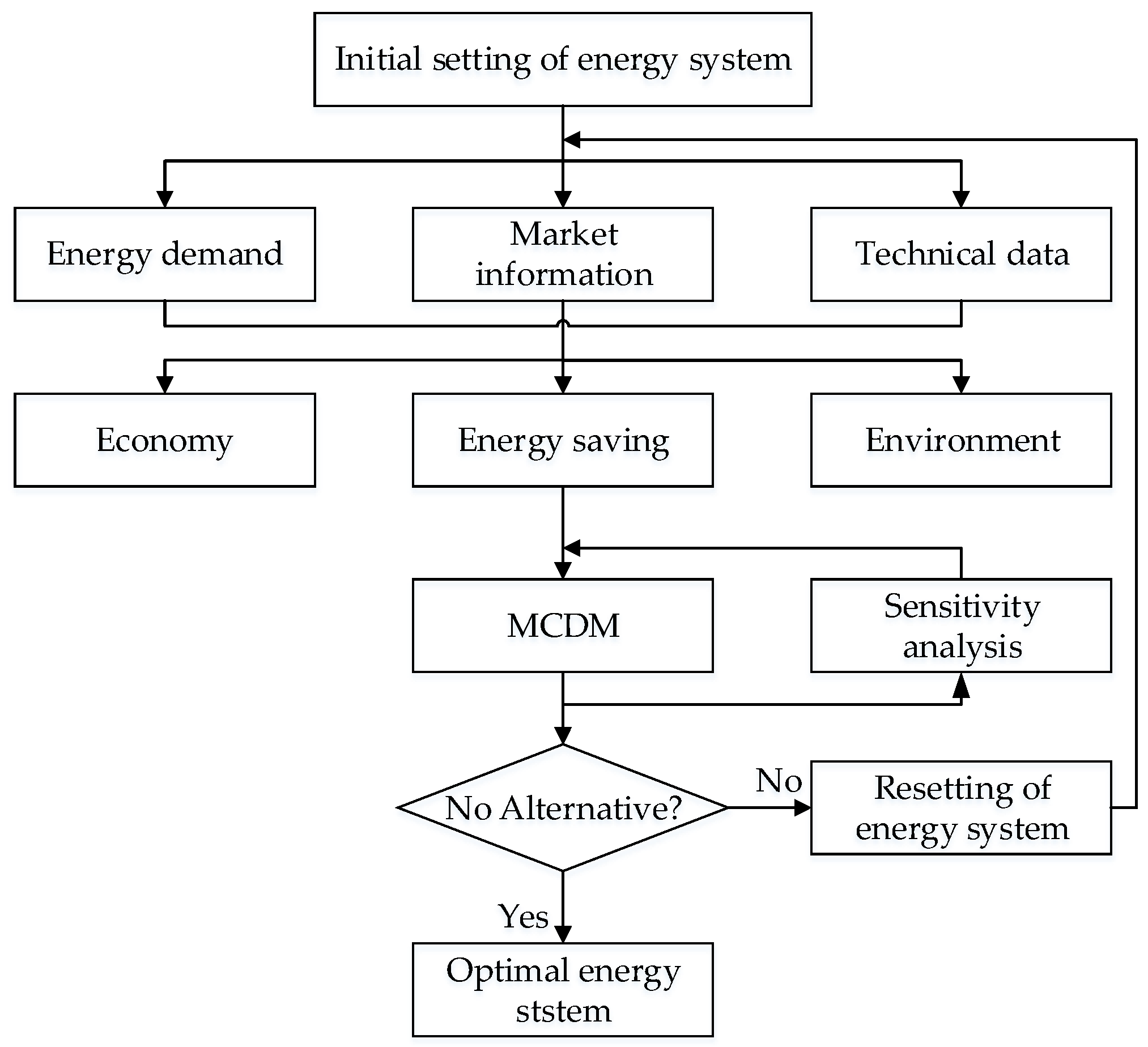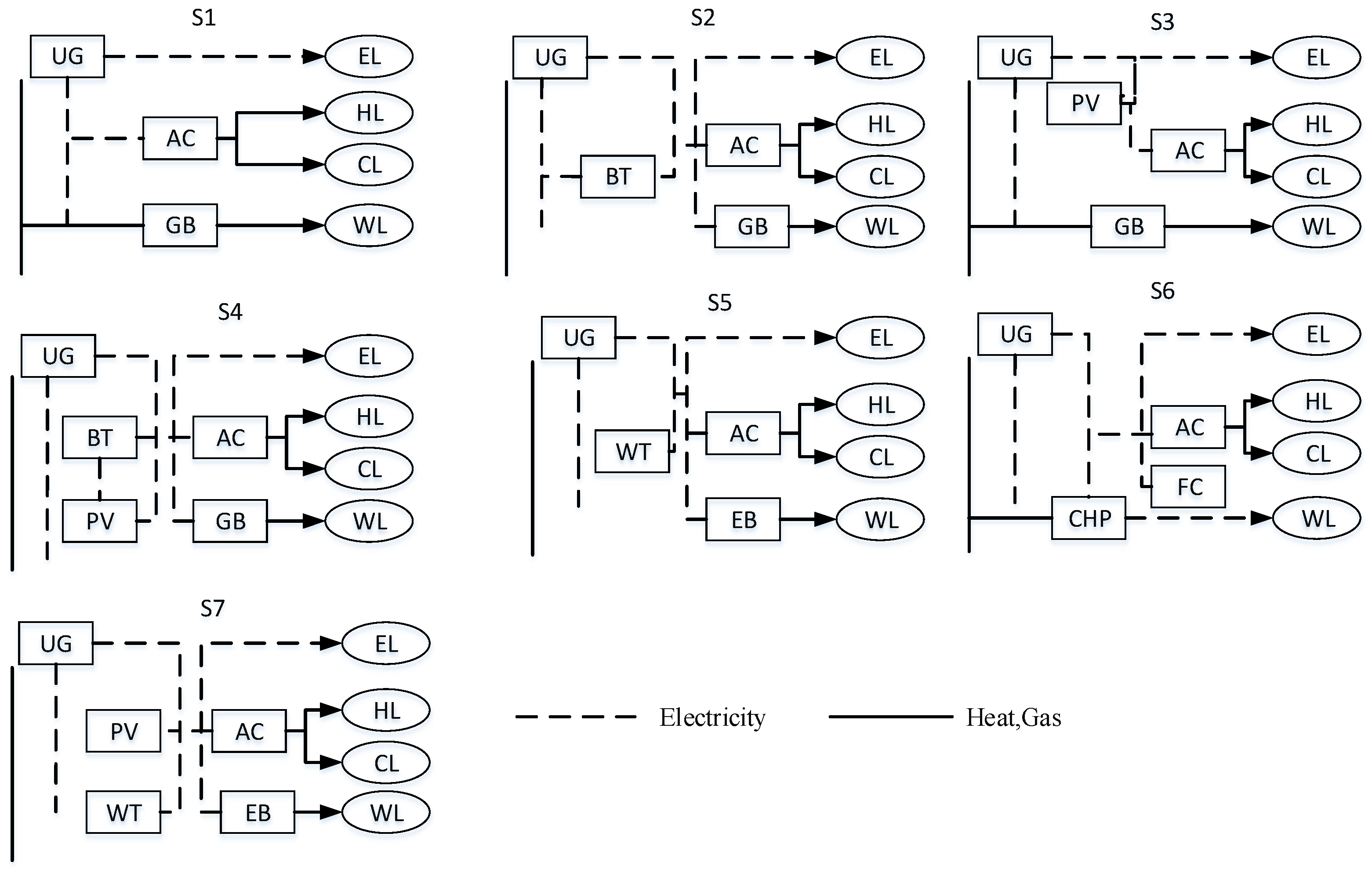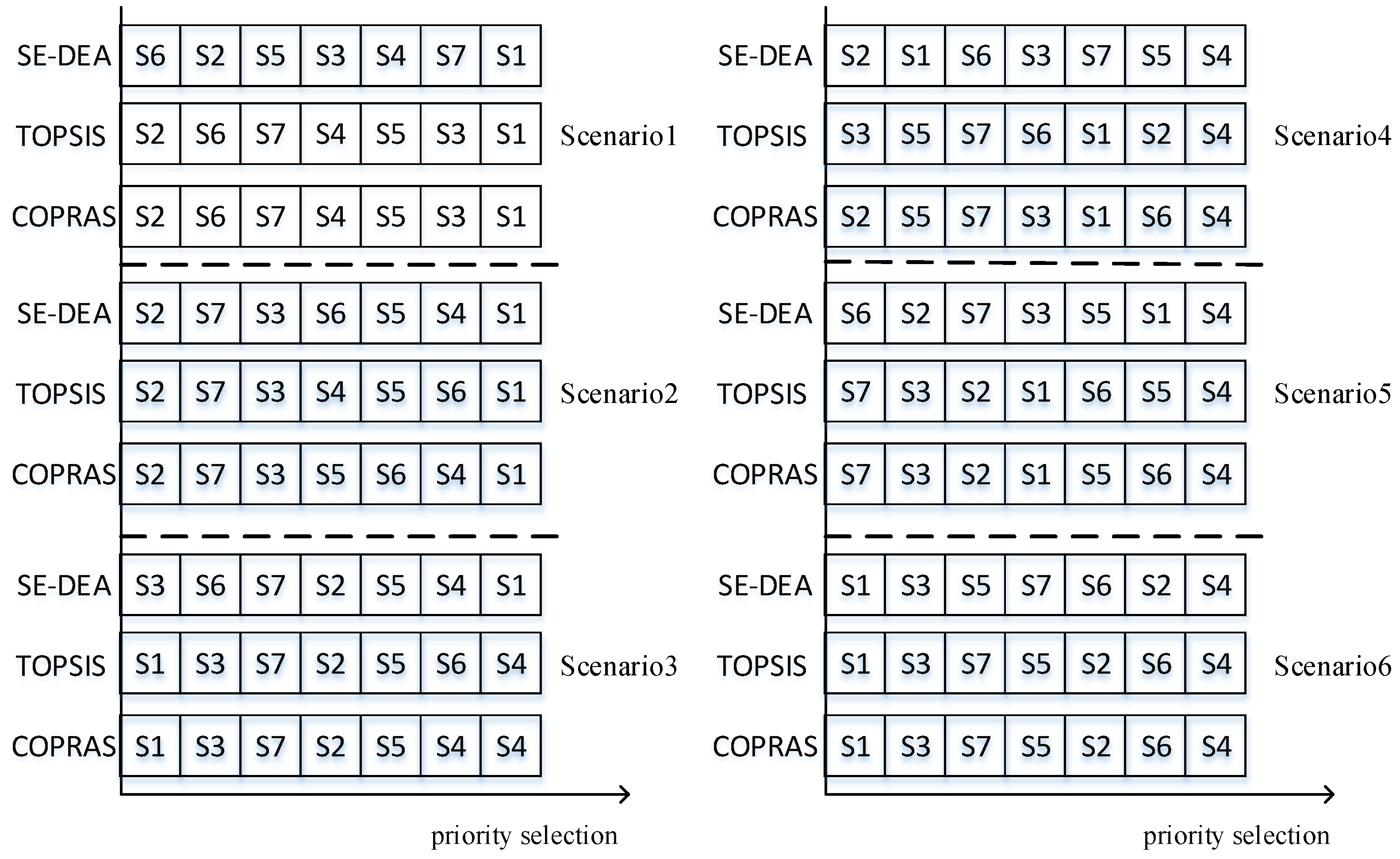1. Introduction
A distributed energy system (DES) is based on the concept of energy cascade utilization, distributed on the demand side to achieve the comprehensive utilization of resources and renewable energy. According to the different needs of the demand-side energy-users, a DES aims to achieve the effective supply of energy, minimize the loss of transportation links, and maximize the efficiency of energy utilization.
China has a vast territory, and increasingly more power users are scattered around the country. The centralized supply of energy is difficult and the cost is high; however, a DES can effectively achieve demand-side management, reduce load peak-valley difference, reduce power supply costs, and bring about a revolutionary impact on the traditional way to supply energy [
1]. Thus, DESs have a broad developmental prospect. However, with the development and maturity of different energy technologies, increasingly more technology is becoming available. For decision-makers, choosing the best DES is a complex and key issue. The traditional decision-making using cost as the single decision criterion cannot adapt to the purpose of sustainable development [
2,
3]. Therefore, it is necessary to consider a variety of factors comprehensively, to evaluate the DES with multiple criteria, and to ensure that the needs of the decision-makers are met.
The multi-criteria decision-making (MCDM) model provides effective ideas and methods for decision-makers. Kavvadias and Maroulis applied the multi-criteria optimization method to the cold and heat triple energy system of a hospital, and selected technology, economy, energy saving, and the environmental protection index as the optimization criteria. They obtained the optimal device capacity and operation strategy [
4]. Piacentino and Cardona took a large hotel in Italy as the research object, combining the optimization of the economic standards and energy environmental standards to optimize the optimal configuration design of the system [
5]. Similarly, Wang et al. made a detailed summary of the multiple attribute evaluation and decision-making methods in aspects of technology, economy, environment, and society [
6]. Ren Hongbo et al., taking the distributed residential energy system in Japan as an example, integrated linear programming and the MCDM model. They evaluated the economics, energy efficiency, and environmental protection of the scheme selection of the energy system. However, the optimal solutions of different evaluation objectives and criteria and different evaluation methods are often uncertain. Therefore, further optimization and analysis of the evaluation results are needed [
7]. Fetanat A et al. combined the fuzzy MCDM model, network analysis, decision-making, and evaluation test to find the best construction site for an offshore wind farm in southwestern Iran and to optimize the decision result robustly [
8]. Mousavi-Nasab Seyed Hadi and Sotoudeh-Anvari [
9] proposed a rank reversal model as a complement to the MCDM model. There are many evaluation methods for the MCDM model, including AHP (Analytic Hierarchy Process), VIKOR (VlseKriterijumska Optimizacija I Kompromisno Resenje), Technique for Order Preference by Similarity to an Ideal Solution (TOPSIS), Elimination and Choice Translating Reality (ELECTRE), Simple Additive Weighting (SAW), Preference Ranking Organization Method for Enrichment Evaluation (PROMETHEE), Data Envelopment Analysis (DEA), Complex Proportional Assessment (COPRAS), etc. A comparison between various methods is given in References [
10,
11,
12]. The main methods chosen in this paper are DEA, TOPSIS, and COPRAS.
The decision-making of a DES can be regarded as a multi-criteria decision-making problem. The decision-making criteria are considered inthree aspects of economy, energy efficiency, and environmental protection. The basic outline of the whole decision-making process can be illustrated in
Figure 1. Following the initial information and data of the local condition, some system alternatives can be designed to take economy, energy, and environment into consideration. Subsequently, according to the basic data of system alternatives, and by using a specific MCDM method, the overall evaluation is achieved. In order to account for the uncertainty of decision-making criteria, the sensitivity analysis is executed. Thus, all alternative energy systems are evaluated, and the ranking of the optimal energy systems can be determined.
According to the literature [
13,
14,
15,
16], the main evaluation criteria for DESs include investment cost (IC), operating cost (OC), primary energy consumption (EC), primary energy utilization (EU), and CO
2 emissions (CE).
3. System Scheme Evaluation
Hypothesis 1. Decision-makers take investment cost as the most important decision criterion.
3.1. Super-Efficiency DEA Application
In the initial evaluation of each system, it was assumed that the investment cost was the most important criterion. In the original data, the primary energy utilization rate was the benefit criterion for the output index and the other was the cost criterion for the input index. In order to realize this hypothesis, the data needed to be converted to some extent; the investment cost was converted to the output index and the other to the input index. The reciprocal transformation method was used to carry out numerical conversion, and LINGO software (LINGGO12.0, Lindo System Inc, Chicago, IL, USA) used for super-efficiency DEA analysis.
The results of the analysis are shown in
Table 3.
When decision-makers only consider investment cost, the traditional energy system is the best choice, while the fuel cell system is the worst choice of system. This is mainly because the traditional system has had to time to be explored and developed. Thus, the key technology has been mastered, and this can then greatly reduce the cost of investment. However, for the fuel cell system, the development cost of the battery group is high, thus its investment cost is far higher than that of the traditional system.
3.2. TOPSIS and COPRAS Application
We used the other two methods to do the same evaluation. Before evaluating via TOPSIS and COPRAS, we first needed to determine the weight of each index. This paper uses AHP to determine the weight. When more attention is paid to the investment cost criterion, the weight of investment cost is largest. The 1–9 scale method [
22] was used to quantify the comparison value, and the above five criteria were compared in pairs. We used a value of 5 (obviously important) to characterize the importance of the investment cost criterion over other criteria. The importance of the other criteria is the same, and was stated as a value of 1. The layer comparison matrix of criteria is shown in
Table 4 and the weights of the criteria are shown in
Table 5.
Among them, the consistency test Consistency Ratio (CR) value was 0 < 0.1, making sure that the judgment matrix had better satisfaction.
According to Equations (2)–(12), we evaluated the system in two ways, using TOPSIS and COPRAS. The results of the calculations are shown in
Table 6.
Similarly, under the TOPSIS and COPRAS methods, the traditional system had the highest priority value and became the optimal system only when the investment cost was paid more attention. The priority values of the fuel cell system and the energy storage system were the lowest, and thus these were the least ideal options. However, for increasingly more investors, merely considering the cost of investment in decision-making cannot meet the economic development requirements and policy constraints. Therefore, more decision-making elements need to be considered. In this paper, six different decision-making scenes were set up to analyze the sensitivity of the optimal system and to detect the least ideal system under different decision criteria. This is to ensure that the multi-criteria decision-making problem of the DES can be studied more comprehensively.
4. Discussion
4.1. Sensitivity Analysis
The above analysis was based on the hypothesis that the investment cost criterion is the most important. The six scenarios in
Table 7 denote the importance of different criteria. In the table, “>” means that the decision-maker attaches more importance to the criterion before “>”, and the criteria before and after “=” are equally important to the decision-maker.
Under different decision-making scenarios, the weights corresponding to each criterion were different. Using the AHP method, we can determine the criteria weight under different scenarios, as shown in
Table 8.
The priority values of each system under the three methods of super-efficiency DEA, TOPSIS, and COPRAS are shown in
Table 9 and the priority ranking comparison is shown in
Figure 3.
As can be seen from
Figure 3, the evaluation results obtained by different evaluation methods were quite different. When taking the investment cost as the decision-making objective, the traditional system was the best option out of the three methods. The energy storage system was the least ideal option due to its lowest priority value. When considering the life cycle of the systems, renewable energy systems such as photovoltaic and wind power systems did not have an advantage in terms of cost. When decision-makers not only consider cost factors, the ranking of system priority will change greatly. The photovoltaic energy storage system had the highest priority value (although its priority value was second under the super-efficiency DEA method, it was the first under the TOPSIS and COPRAS methods, thus it was still considered the highest value. This refers to the choice of decision-making methods, which will be explained later) when considering the energy efficiency and the environmental criteria, which is the optimal choice for decision-makers. Generally speaking, the priority value of renewable energy systems was higher than the other systems, while the traditional system had the lowest priority value, which caused it to be the least ideal option. When the cost and energy efficiency criteria were considered in scenario four, the highest priority of the photovoltaic storage system was considered to be the best system, while the priority value rank of the traditional system will be reduced to a certain extent. Under the two methods of super-efficiency DEA and COPRAS, the photovoltaic system had the lowest priority value and was the least ideal option for decision-making. This was mainly related to the high cost of the photovoltaic system. The PV storage system was the best option for decision-makers who considered the cost and environmental criteria to be more important. The PV storage system was also the best option with comprehensive consideration for the cost, energy efficiency, and environmental criteria.
Although PV storage systems do not have an advantage in cost, the cost factor is no longer the only factor for an increasingly larger number of investors, who decide to instead take energy efficiency and environmental factors into consideration. Therefore, the photovoltaic storage system is ideal in multi-criteria decision-making because of its advantages in cost, energy efficiency, and environment. Additionally, the overall priority of fuel cells is higher, second only to the photovoltaic storage system; however, the investment cost of fuel cells is high, which is one of the key factors that restrict many investors.
As far as this article is concerned, the photovoltaic system was superior to the wind power system, which was related to the relatively less abundant wind resources and the abundant photovoltaic resources in the studied area. However, photovoltaic systems are not necessarily the best option: the energy storage system was not feasible because of its huge cost. However, the combination of photovoltaic power and energy storage technology can greatly improve the economy, energy efficiency, and environmental benefit of the DES, and thus it has become the main option for DESs.
4.2. The Selection of Evaluation Methods
There are many methods for multi-criteria decision-making, and the decision results obtained by different decision-making methods vary. In this paper, only three methods were selected to evaluate the priority values of these six energy systems. As can be seen in
Figure 3, the ranking results obtained by these three methods were different in many decision-making scenarios, and some results even differ greatly. In this paper, the Spearman correlation index was used to analyze the correlation of ranking results under different decision-making methods, to provide tool for the decision-makers to find the appropriate decision-making methods [
23].
is the rank difference of the two decision methods, and
is the number of ranks. The range of the value of
was [−1, 1]; the closer to 1, the higher the consistency of the conclusions of the two methods; however, the closer to −1, the greater the difference between the conclusions of the two methods. Zero indicated that the conclusions obtained by the two methods did not have relevance. For the evaluation results of
Table 9, we used Formula (13) to calculate the index of the three methods under six scenarios, as shown in
Table 10.
As can be seen in
Table 10, the conclusions of super-efficiency DEA and COPRAS were the most relevant to scenario two, while in the other scenarios the Spearman correlation index of TOPSIS and COPRAS was close to +1, or even 1. This shows that TOPSIS and COPRAS were relatively better decision-making methods for the case in this paper.
TOPSIS and COPRAS both consider the weight of the criteria; however, in the super-efficiency DEA analysis, there was no constraint in the weight, which in some cases leads to a greater difference compared to the previous two methods. In scenarios three and four, the correlation coefficient between the super-efficiency DEA, TOPSIS, and COPRAS methods was negative, which shows that the conclusion obtained by using the super-efficiency DEA method was very different from the other two methods. However, this does not mean that the super-efficiency DEA method was invalid. For specific problems, it should be analyzed concretely. Moreover, the weight constraint can be introduced into the DEA model, so that it can solve the problem more accurately.







